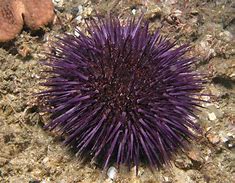
Sea Urchin
Sea urchins are fascinating marine creatures belonging to the class Echinoidea. They are known for their spiny, spherical or disc-shaped bodies and their important ecological roles in marine ecosystems. Here are some interesting facts about sea urchins:
Appearance: Sea urchins have a round or flattened body covered in a hard, calcareous exoskeleton. Their bodies are covered in spines, which can vary in length and thickness depending on the species. Sea urchins come in a variety of colors, including shades of purple, green, red, black, and brown.
Habitat: Sea urchins are found in oceans worldwide, from shallow coastal areas to deep-sea environments. They inhabit a range of habitats, including rocky reefs, coral reefs, seagrass beds, and sandy or muddy seabeds. Some species live in intertidal zones, while others dwell in the abyssal depths.
Feeding Habits: Sea urchins are primarily herbivorous, feeding on algae and other plant material. They use their specialized mouthparts, called Aristotle’s lantern, to scrape and graze on surfaces, such as rocks or coral, removing algae and other organic matter. Their feeding activities can have significant effects on the balance of marine ecosystems.
Spines and Defense: The spines covering a sea urchin’s body serve as a defensive mechanism against predators. When threatened, a sea urchin can erect and move its spines to create a protective barrier. Some sea urchins also have venomous spines that can cause painful stings or irritation.
Reproduction: Sea urchins have separate sexes, with individuals being either male or female. They release their eggs and sperm into the water, where fertilization occurs. The resulting larvae undergo a pelagic stage before settling on the seafloor and developing into adult sea urchins.
Regeneration: Sea urchins have remarkable regenerative abilities. If a sea urchin loses a limb or sustains damage, it can regenerate the lost body part over time. This regrowth ability helps them recover from injuries and adapt to changing environmental conditions.
Importance in Marine Ecosystems: Sea urchins play vital ecological roles in marine ecosystems. As herbivores, they help control the growth of algae, preventing overgrowth and maintaining a healthy balance. In some areas, overpopulation of sea urchins due to the decline of their natural predators can lead to destructive overgrazing of kelp forests and coral reefs.
Economic Importance: Sea urchins have economic value in various industries. Their roe, known as uni, is a delicacy in many cuisines, particularly in Japanese cuisine. Uni is highly sought after for its rich flavor and is used in sushi, sashimi, and other seafood dishes.
Calcium Carbonate Structure: Sea urchins’ exoskeletons, including their spines, are made of calcium carbonate, which gives them their hard and rigid structure. These structures play a role in protecting the sea urchin’s body and providing support.
Research and Conservation: Scientists study sea urchins to better understand their biology, reproduction, and ecological interactions. Conservation efforts focus on maintaining healthy sea urchin populations and managing their impact on marine ecosystems. Protecting the habitats they rely on, such as coral reefs and kelp forests, is crucial for their survival.